Hopscotch: A Mobile Opera and One Incredible Journey through Los Angeles

The window rolls down, seemingly by itself, and from the loading dock of a building, a trumpet blares like an eerie car horn in traffic. The window rolls up; we’re still moving. The music escalates in emotional pitch as the car circles a loop again and again, the window rolling down and up, each time revealing an additional trumpeter; the sound as we pass gaining in intensity and dissonance until suddenly, we stop. One woman in yellow breaks off, jumps out of the car, and is enveloped in a massive black cloth that covers the limo. She sings and struggles against the blackness and the window. She escapes; we are whisked away.
This was my first journey into Hopscotch, a new opera by avant-garde production company, The Industry. After experiencing their show Invisible Cities, the headphone opera performed at Los Angeles’ Union Station, I should have known I was in for something challenging, innovative, complex, and epic. I had no idea. Hopscotch fractures everything you think you know about opera, and forces you to stretch your brain to reference aspects of art, music, science, history, and architecture that you probably didn’t even realize that you’d known or forgotten.
The show takes place in and out of various cars, with audience members riding along, following characters into buildings, through parks, on rooftops, in elevators, and out again. There are three separate routes; color coded red, yellow, and green, that each have their own chapters which make up part of the larger story. One of the four audience members in each car is handed a mobile phone that streams the performance back to a central hub. But wait, we’ll get there, eventually. We’re moving again.
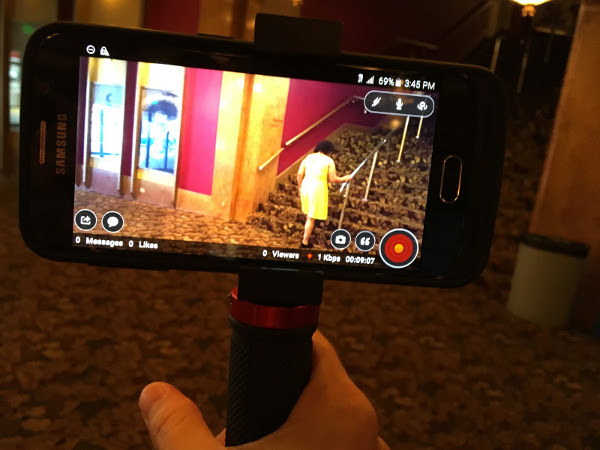
Now we’re walking, following a young actor in a leather jacket into a studio space. Inside, two singers: one with a marionette in a yellow skirt, and another performing as an aerialist, swirl and sing in spikes of light. They are telling the story of Orpheus, the mythical musician who chased his love into hell, only to lose her when he, against instruction, turns to look back at her
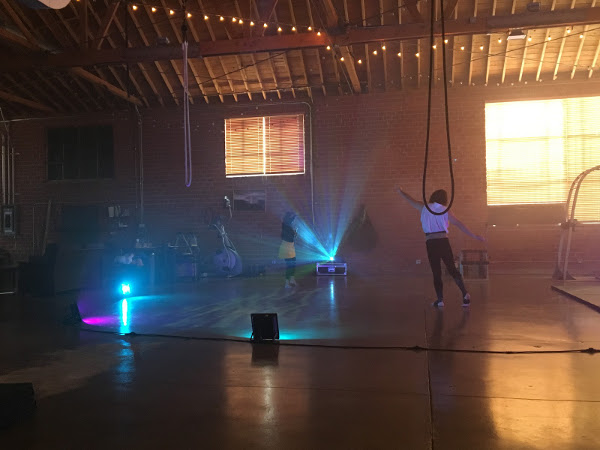
A love story begins. As we follow the actors outside into the light, the city of Los Angeles invades our consciousness. A woman bicycles by. She is singing now. She is part of the performance. There is graffiti: two names in a heart, carved into a light pole. Is that part of the show? No matter, it is now. That’s just how Hopscotch works.
We’re in a limo again, and a man in a leather jacket is adjusting the levels of water in a glass, tapping it with a stick, checking the pitch, and creating a melody. A beautifully acted voiceover plays through the sound system. We zoom through tunnels, and the windows drop, and I realize that the large box I’d noticed strapped to the roof of the vehicle was a projector, and now animation is being cast onto the walls of the tunnel as we pass. It’s moving. We’re moving. We’re with the character Jameson, and at first, it’s hard to tell where we are in his timeline.
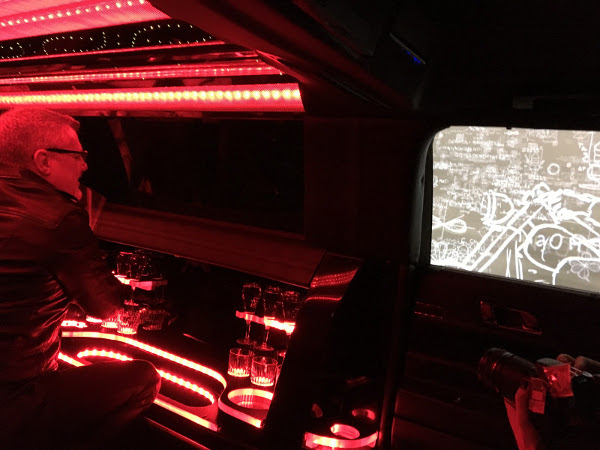
But that’s the very idea: we are presented chapters of a central story, out of order, and without access to the entire book. Like a chance meeting with a new person in the city, it is up to the audience member to decide if and how they want to explore further and deeper into the larger narrative.
You can be a part of the show on all three routes, watch omnisciently from the central hub, piece it all together from one route with the help of a book provided at the end of the show, fill in more gaps with the addition of animated segments available online, or just sit back and go along for the ride. That said, even after viewing all aspects, Hopscotch is a puzzle that is missing a piece, and thus requires the audience to fill in the gaps. Like it or not, your perception is part of the story, too.
Hopscotch is not only a love story about people, but a love story about Los Angeles. The routes explore a five mile radius around the arts district and intertwine the action with iconic landmarks like the Bradbury building, Elysian Park, and The Million Dollar Theater. As we hop in and out of cars, Los Angeles becomes a character. There is literally nowhere else in the world this show could be performed.

As we are in the public space the public blends in and out of your awareness. Some people stop and watch the show with you, whipping out a smartphone. Some are so engrossed in their own lives that a man dressed in a lab coat furiously pacing the street doesn’t raise an eyebrow.

The buildings or actions outside sometimes grab your attention, sometimes it’s as though there’s nothing in the world but what’s the inside of your car. If there’s a better way to express life in LA, I don’t know what it is.
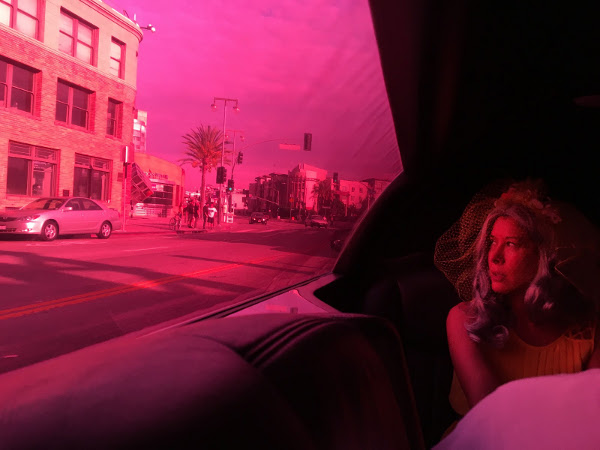
As we complete our circuit, our car pulls into the center hub. It’s a huge architectural structure that echoes the fractal designs in one of the animations I watched before the show.
The central hub is filled with television screens, each live-streaming a chapter, and hub audience members are fitted with a set of wireless Sennheiser headphones. You’re invited to walk about in the round, viewing each chapter as it unfolds somewhere in the city of Los Angeles in real time.
One by one, all of the players from the show arrive in cars and emerge into the center. It’s time for the grand finale. This happens once a day, at the end of the 2:45pm performance. Each actor mills about, singing their own list of thoughts, adding to a rising din as more and more join in.
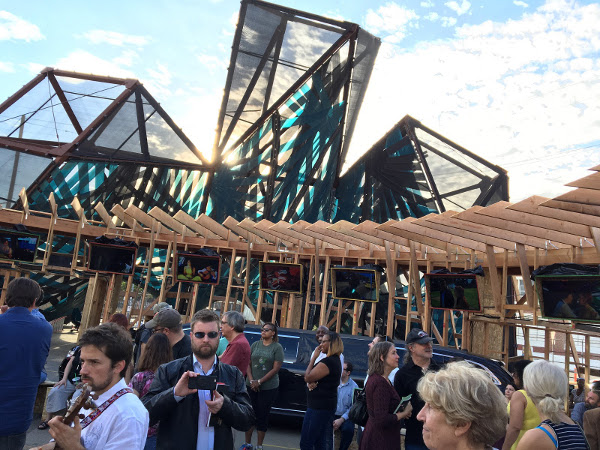
They stand beside us, among us, and as I take in the scene, I’m struck with just how enormous an undertaking Hopscotch is. From permits with the Department of Transportation, to dozens of actors and musicians, to stage managers and professional drivers, Hopscotch is amazingly smooth and seamless in spite of the complexity.
What’s more is the incredible use of technology: wireless mics in moving cars, signal towers on rooftops, headphones that respond to your location in the hub, headbands that read your brainwaves and change the recorded performance (yes, really), projectors spewing animation on tunnels, cameras in the hands of the audience, broadcasting to another audience, live. All cogs working together so flawlessly in the background that all we as an audience experience is the art.
I look up at a screen. Back in the performance studio, The man in the leather jacket knocks something over. The music stops. The scene moves on, outside, and a question is projected onto the floor as we exit

The idea of a journey, into hell, through past and future, and back is central to Hopscotch, and it is expressed using nearly every form of artistic expression: music, acting, video, animation, architecture, and even interactive new media. Like the very streets we drive, the story winds in and out, starting and stopping like the infamous LA traffic. We experience what we can, as best we can, before we’re carried away to the next chapter. But there’s no time to contemplate that now: the car is here, and it will leave without us.
Hopscotch opens October 31st and runs weekends through November 15th. Tickets for riding in the cars are available at HopscotchOpera.com. Viewing at the Central Hub is free, but first-come-first-served starting at 12:30pm.
- Log in or register to post comments






























































